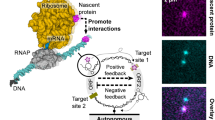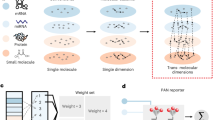Abstract
Rapid, multiplexed, sensitive and specific molecular detection is of great demand in gene profiling, drug screening, clinical diagnostics and environmental analysis1,2,3. One of the major challenges in multiplexed analysis is to identify each specific reaction with a distinct label or 'code'4. Two encoding strategies are currently used: positional encoding, in which every potential reaction is preassigned a particular position on a solid-phase support such as a DNA microarray5,6,7,8, and reaction encoding, where every possible reaction is uniquely tagged with a code that is most often optical or particle based4,9,10,11,12,13. The micrometer size, polydispersity, complex fabrication process and nonbiocompatibility of current codes limit their usability1,4,12. Here we demonstrate the synthesis of dendrimer-like DNA-based, fluorescence-intensity-coded nanobarcodes, which contain a built-in code and a probe for molecular recognition. Their application to multiplexed detection of the DNA of several pathogens is first shown using fluorescence microscopy and dot blotting, and further demonstrated using flow cytometry that resulted in detection that was sensitive (attomole) and rapid.
This is a preview of subscription content, access via your institution
Access options
Subscribe to this journal
Receive 12 print issues and online access
$259.00 per year
only $21.58 per issue
Buy this article
- Purchase on SpringerLink
- Instant access to full article PDF
Prices may be subject to local taxes which are calculated during checkout




Similar content being viewed by others
References
Han, M., Gao, X.H., Su, J.Z. & Nie, S. Quantum-dot-tagged microbeads for multiplexed optical coding of biomolecules. Nat. Biotechnol. 19, 631–635 (2001).
Fulton, R.J., McDade, R.L., Smith, P.L., Kienker, L.J. & Kettman, J.R. Advanced multiplexed analysis with the FlowMetrix(TM) system. Clin. Chem. 43, 1749–1756 (1997).
Steemers, F.J., Ferguson, J.A. & Walt, D.R. Screening unlabeled DNA targets with randomly ordered fiber-optic gene arrays. Nat. Biotechnol. 18, 91–94 (2000).
Braeckmans, K., De Smedt, S.C., Leblans, M., Pauwels, R. & Demeester, J. Encoding microcarriers: Present and future technologies. Nat. Rev. Drug Discov. 1, 447–456 (2002).
Duggan, D., Bittner, M., Chen, Y., Meltzer, P. & Trent, J. Expression profiling using cDNA microarrays. Nat. Genet. 21, 10–14 (1999).
DeRisi, J. et al. Use of a cDNA microarray to analyse gene expression patterns in human cancer. Nat. Genet. 14, 457–460 (1996).
Schena, M., Shalon, D., Davis, R. & Brown, P. Quantitative monitoring of gene-expression patterns with a complementary-DNA microarray. Science 270, 467–470 (1995).
Cheung, V.G. et al. Making and reading microarrays. Nat. Genet. 21, 15–19 (1999).
Cunin, F. et al. Biomolecular screening with encoded porous-silicon photonic crystals. Nat. Mater. 1, 39–41 (2002).
Wang, J., Liu, G.D. & Rivas, G. Encoded beads for electrochemical identification. Anal. Chem. 75, 4667–4671 (2003).
Chan, W.C. et al. Luminescent quantum dots for multiplexed biological detection and imaging. Curr. Opin. Biotechnol. 13, 40–46 (2002).
Nicewarner-Pena, S.R. et al. Submicrometer metallic barcodes. Science 294, 137–141 (2001).
Nam, J.M., Thaxton, C.S. & Mirkin, C.A. Nanoparticle-based bio-bar codes for the ultrasensitive detection of proteins. Science 301, 1884–1886 (2003).
Li, Y. et al. Controlled assembly of dendrimer-like DNA. Nat. Mater. 3, 38–42 (2004).
Luo, D. The road from biology to materials. Mater. Today 6, 38–43 (2003).
Ried, T., Baldini, A., Rand, T.C. & Ward, D.C. Simultaneous visualization of 7 different DNA probes by in situ hybridization using combinatorial fluorescence and digital imaging microscopy. Proc. Natl. Acad. Sci. USA 89, 1388–1392 (1992).
Taton, T., Mirkin, C. & Letsinger, R. Scanometric DNA array detection with nanoparticle probes. Science 289, 1757–1760 (2000).
Sjostedt, A., Eriksson, U., Berglund, L. & Tarnvik, A. Detection of Francisella tularensis in ulcers of patients with tularemia by PCR. J. Clin. Microbiol. 35, 1045–1048 (1997).
Sanchez, A. et al. Detection and molecular characterization of Ebola viruses causing disease in human and nonhuman primates. J. Infect. Dis. 179, S164–S169 (1999).
Poon, L.L. et al. Detection of SARS coronavirus in patients with severe acute respiratory syndrome by conventional and real-time quantitative reverse transcription-PCR assays. Clin. Chem. 50, 67–72 (2004).
Fuja, T., Hou, S. & Bryant, P. A multiplex microsphere bead assay for comparative RNA expression analysis using flow cytometry. J. Biotechnol. 108, 193–205 (2004).
Vignali, D.A. Multiplexed particle-based flow cytometric assays. J. Immunol. Methods 243, 243–255 (2000).
Wang, J. et al. Adsorption and detection of DNA dendrimers at carbon electrodes. Electroanal. 10, 553–556 (1998).
Wang, J., Jiang, M., Nilsen, T. & Getts, R. Dendritic nucleic acid probes for DNA biosensors. J. Am. Chem. Soc. 120, 8281–8282 (1998).
Nilsen, T., Grayzel, J. & Prensky, W. Dendritic nucleic acid structures. J. Theor. Biol. 187, 273–284 (1997).
Capaldi, S., Getts, R.C. & Jayasena, S.D. Signal amplification through nucleotide extension and excision on a dendritic DNA platform. Nucleic Acids Res. 28, e21 (2000).
Lowe, M., Spiro, A., Zhang, Y. & Getts, R. Multiplexed, particle-based detection of DNA using flow cytometry with 3DNA dendrimers for signal amplification. Cytom Part A 60A, 135–144 (2004).
Shchepinov, M., Mir, K., Elder, J., Frank-Kamenetskii, M. & Southern, E. Oligonucleotide dendrimers: stable nano-structures. Nucleic Acids Res. 27, 3035–3041 (1999).
Shchepinov, M., Udalova, I., Bridgman, A. & Southern, E. Oligonucleotide dendrimers: synthesis and use as polylabelled DNA probes. Nucleic Acids Res. 25, 4447–4454 (1997).
Acknowledgements
We wish to acknowledge the Cornell Center for Advanced Technology and the Cornell Center for Vertebrate Genomics for financial support. This material is based upon work supported in part by the Science and Technology Center Program of the National Science Foundation under agreement no. ECS-9876771. We thank Yung-Fu Chang for providing pathogen genomic DNA (Mycobacterium avium subsp. paratuberculosis) and Carol Bayles for technical support on microscopy.
Author information
Authors and Affiliations
Corresponding author
Ethics declarations
Competing interests
A patent for similar technology is being filed, the value of which may be increased by this publication.
Supplementary information
Supplementary Fig. 1
Evaluation of nanobarcodes with agarose gel electrophoresis. (PDF 745 kb)
Supplementary Fig. 2
Schematic drawing of nanobarcode denaturation (without showing fluorescence dyes). (PDF 96 kb)
Supplementary Fig. 3
DNA nanobarcode quantitative decoding based on microbead populations. (PDF 42 kb)
Supplementary Fig. 4
Statistics multiplexed DNA detection using flow cytometry. (PDF 55 kb)
Supplementary Table 1
Building oligonucleotides (PDF 47 kb)
Supplementary Table 2
Capture probes, report probes and target DNA (PDF 47 kb)
Supplementary Table 3
Y-DNA building blocks (PDF 43 kb)
Supplementary Table 4
DNA nanobarcodes (PDF 40 kb)
Supplementary Table 5
Code library (PDF 45 kb)
Rights and permissions
About this article
Cite this article
Li, Y., Cu, Y. & Luo, D. Multiplexed detection of pathogen DNA with DNA-based fluorescence nanobarcodes. Nat Biotechnol 23, 885–889 (2005). https://doi.org/10.1038/nbt1106
Received:
Accepted:
Published:
Issue date:
DOI: https://doi.org/10.1038/nbt1106
This article is cited by
-
Single-particle combinatorial multiplexed liposome fusion mediated by DNA
Nature Chemistry (2022)
-
Nuclease resistance of DNA nanostructures
Nature Reviews Chemistry (2021)
-
Hybrid material of structural DNA with inorganic compound: synthesis, applications, and perspective
Nano Convergence (2020)
-
Disposable silicon-based all-in-one micro-qPCR for rapid on-site detection of pathogens
Nature Communications (2020)
-
Encoding quantized fluorescence states with fractal DNA frameworks
Nature Communications (2020)



